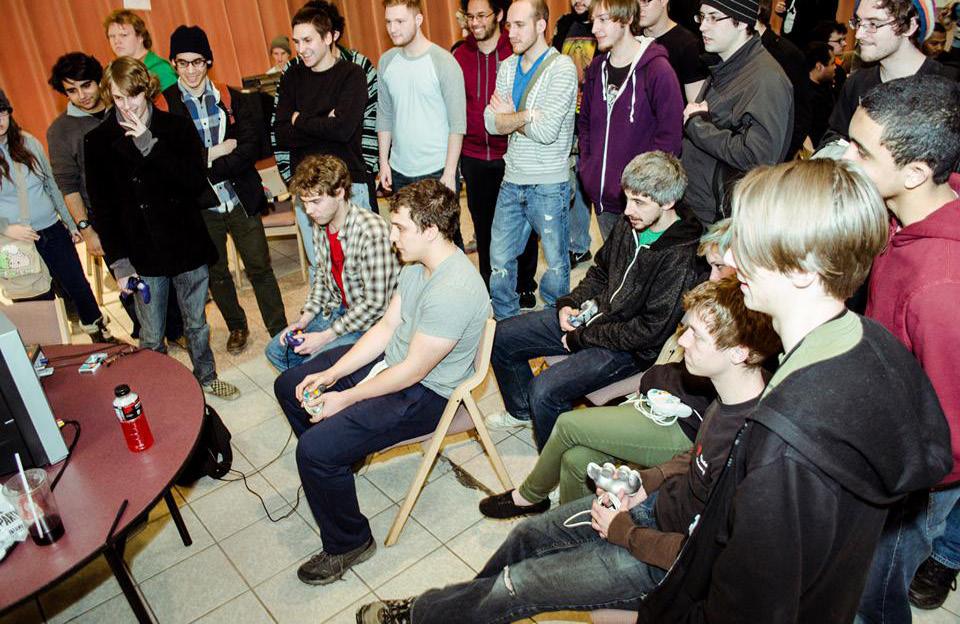Imagine an auditorium filled with thousands of people all here to watch you and others like you. You have been playing the game you’ve practiced for years all day, in intense one-on-one matches. You’ve beaten everyone except the person who now sits next to you. They are the only thing standing in between you and your goal: To win it all; the glory and the money. The announcers rile the crowd to a fever pitch and the round starts. It all comes down to the next 40 minutes, will you win or just become another footnote on your opponents path to fame.
This is the dream of most people who consider themselves a part of the Super Smash Brothers Melee community. They bond over a fighting game that’s been out for nearly 20 years and their love for said game. The game was made as a party games where both parents and children could “fight” each other in a virtual world with famous Nintendo characters.

A group of players engaged in combat. Photo by Vincent Delucca
The only reason this game is still alive to this day is because of the community. For the first couple months after its release, people would never have dreamt of this silly game to become a competitive powerhouse. However, about six months after its release, people accidentally discovered exploits in the game which are basically mechanics or things you can do in the game that were not actually intended to exist. These mechanics added a next level of depth to the game that the developers of the game did not see coming. It seemed like every couple months a new exploit in the game was being discovered and the more they were discovered the more in depth the game became. In 2006, Major League Gaming realized that this party game was actually competitive through watching youtube videos of people playing in homegrown tournaments and decided to let them into the MLG circuits alongside other competitive games at the time such as Halo and Street Fighter.
The game was finally recognized for its depth and seemed like it was here to stay. Unfortunately though, Nintendo was enraged that their party game had become a competitive game. The reason they made this game was to appeal to an audience of casual gamers so when it became this widely accepted competitive fighting game, Nintendo intended to end that. They made Super Smash Brothers: Brawl. Their intention was to destroy any remnant of competitive Smash Brothers players by making a game that was anti-competitive. The game had no depth and they made sure of that by taking out everything the old game had to offer to the competitive scene. People tried to play the game competitively for a little while but quickly realized that the game was not competitive. The reign was abruptly, and perhaps unjustly, ended. Or so we thought.
After people realized Brawl was not competitive, people wanted to go back to Melee. From the various forms of social media that existed around 2008, Melee players and fans congregated to revive the original game that they knew and loved. Though Reddit, Facebook, Twitter, and Youtube, Melee slowly began its respawn from its own death. Respawn is a term used in video games to describe a character, that has died, coming back to life. I thought it would be fitting to describe Melee in such a way.
In 2009, an annual tournament was created that is still running to this day. The Revival of Melee tournament, or ROM, is held in upstate New York and people from all over the world gather to play Melee, socialize, and watch the game be played at the highest level to this day. Nintendo attempted to assassinate the game two more times since then. One time they attempted to bribe the people streaming these events on the internet to stop streaming them. That almost worked, however, in the end it backfired. The community shunned the people accepting the bribes and Melee then lived on.
The other attempt occurred when there was an international fighting game tournament in New Jersey that was supposed to be held in a hotel. However, the roof caved in the night before from a storm. The Melee community, could not find a venue for the tournament on such short notice so, and did not know what to do. That day, it seemed like they were completely out of options. Nintendo thought it would be a good idea to seize this opportunity to end Melee. They gave the tournament managers an ultimatum. The managers could either accept Nintendo’s money for a new venue in exchange for removing Melee from the tournament or not have a tournament at all. The managers asked the community on every social media outlet what they as a community should do and through social media the players rose up against Nintendo. They crowd funded their own venue through the spectators, players, and sponsors of the tournament through various social media outlets. In doing so, the tournament and Melee were saved. If it wasn’t for the community, Melee would have been long gone by now.
 NOLAbeings
Multimedia artist Claire Bangser created NOLAbeings as a portrait-based story project that marries...
NOLAbeings
Multimedia artist Claire Bangser created NOLAbeings as a portrait-based story project that marries...
 Data corner: Adobe Suite (create a PDF, social media graphic, presentation, edit a photo and video
Data corner is where you go to work with analytics and top tech skills. It takes on everything from PERL and SQL to Canva and Sprout Social.
Data corner: Adobe Suite (create a PDF, social media graphic, presentation, edit a photo and video
Data corner is where you go to work with analytics and top tech skills. It takes on everything from PERL and SQL to Canva and Sprout Social.
